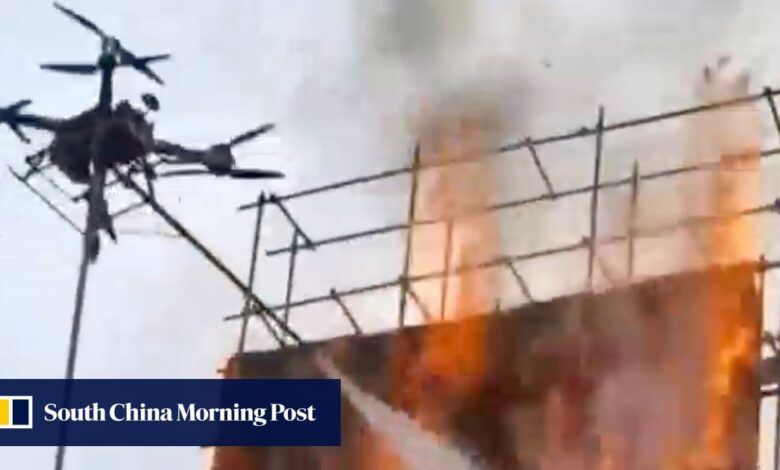Chinese AI drone system aims to hit fires in hard-to-reach places before they turn into big blazes

The new firefighting drones aim to address slow response times typically associated with urban and forest fire rescues during the initial stages of an emergency.
XCMG Group employees at the expo said the system had undergone two high-rise rescue drills in Chongqing province in southwestern China. It had also been deployed in forest fire prevention and proved efficient at tackling re-ignition points and inaccessible terrain, according to the staff at the event.
For forest deployments, the base system could be integrated into a laptop-sized terminal with a control system equivalent to standard handheld devices.
“When a fire breaks out, the reconnaissance drone is deployed first to survey the scene, transmitting real-time images back to the vehicle’s control room and automatically plotting a safe and swift route for the rescue.
“Fire rescue drones then follow the predetermined path, arriving quickly at the scene to initiate firefighting measures. The fire truck can also be rapidly sent to the site for additional support,” he added.
The reconnaissance drone is equipped with automatic cruising, high-altitude surveillance and automated battery replacement among its features. It has extended visibility in complex urban and forest environments.
The two fire-rescue drones can carry a payload of up to 50kg (110lbs) and have a flying height of 120 metres (394 feet) and an operational time of 20 minutes. They can be fitted with dry-powder fire extinguishing bombs or pressurised storage tanks and can tow hoses to spray compressed air foam. The drones are capable of spraying up to 15 metres in the air and can carry out high-altitude rescues and material drops.
Canada wildfires inflict brutal toll on tourism, other areas of economy
Canada wildfires inflict brutal toll on tourism, other areas of economy
In March, the fire brigade of Nyingchi in the Tibet autonomous region collaborated with Keweitai, a company based in Shenzhen, to use drones to suppress a forest fire within a canyon. They targeted 10 primary ignition points, varying dramatically in elevation from 1,065 metres to 1,998 metres.
The challenging topography rendered the area virtually inaccessible to human firefighters and elevated drones to a critical role in the rescue mission. The drones were piloted by trained professionals to successfully extinguish all smoke and fire sources by airdropping water bags onto the affected areas.
The drones used were easy to carry, simple to operate, and quick to respond but cannot navigate autonomously, according to the Keweitai website.
Dutch company Deltaquad has launched firefighting drones that use thermal imaging and image recognition for forest wildfire detection. Likewise, Jacinto, a Portuguese fire truck company, has partnered with two other firms and the University of Coimbra on a similar project that aims to extinguish fires before they escalate into megafires.
The XCMG drone’s flight control system was optimised for complex fire situations, offering superior stability and performance compared to commercial drones, technical personnel at the expo said.
“When deployed for urban rescues, the fire rescue drones have to withstand the explosive gas flows that may erupt from windows at the fire site. It’s a challenge the XCMG team has specifically addressed through extensive data collection and some sacrifices in operational time,” the company’s technical personnel said.
Chinese team tries out special drones to sharpen carbon emissions count
Chinese team tries out special drones to sharpen carbon emissions count
“The system showcased now is the fifth-generation product which began development in 2017, and the next generation – expected to feature a larger payload and independent firefighting units directly mounted on the drones – is slated for release early next year,” according to XCMG.
“The system is designed to operate within the first 20 minutes of a fire outbreak, by which time, according to domestic rescue standards, backup forces should also have arrived on the scene, completing the drone’s early rescue mission,” said an industry observer who asked not to be named.





